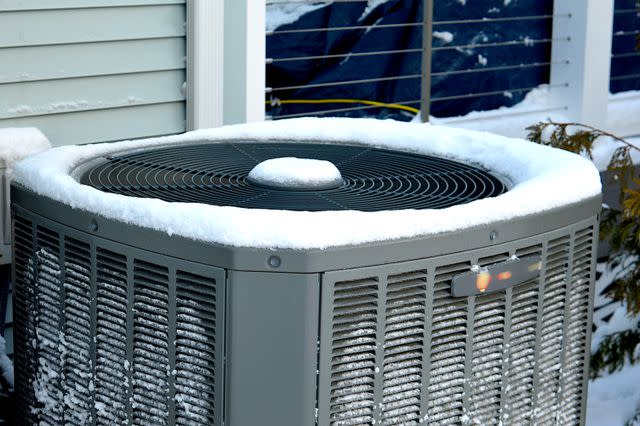Complete These 8 HVAC Maintenance Tasks Before Cold Weather Arrives
Keep your heating system performing its best all winter long.
Once the leaves start falling, cold weather is sure to follow. Is your HVAC unit ready? Preparing your HVAC system for cold weather sets it up for success, helping to ensure you stay warm and cozy all winter. Failure to inspect and maintain the unit before cold weather arrives could result in it failing when you need it most.
This checklist will guide you through the HVAC maintenance tasks you should complete before cold weather arrives.

Getty Images / Philippe Gerber
HVAC Pre-Winter Checklist
1. Test the Thermostat
One of the easiest and most effective things you can do to prep your HVAC system for winter is to make sure your thermostat is working correctly. To do so, click through every function and wait to ensure the unit responds. Set the heat to a specific temperature to confirm it’s activating the heat system as it should.
If your system has an emergency heat function that supplements or replaces the heat pump when temperatures are too cold, check its functionality as well. Many thermostats, especially smart thermostats, can be programmed to trigger emergency heat when the outside temperatures drop below a certain threshold.
Warning
Emergency heat earned its name for a reason. It’s not meant to be used as a primary heat source; it’s much less efficient and more expensive than a heat pump.
Related: The 8 Best Smart Thermostats
2. Replace the Air Filter
Change your return filters regularly to keep the system running well and maintain your home’s air quality. Households with multiple pets could need new air filters multiple times a month. Dirty air filters restrict airflow.
Your HVAC system relies on ample airflow to function correctly, so restricting the airflow can cause the system to malfunction. If you haven’t changed your return air filters in a while, let the change in season be a reminder.
If your HVAC system utilizes reusable filters, follow these instructions for cleaning an air filter.
3. Check the Ductwork
Head to the crawlspace, basement, attic, or wherever your ductwork lies and do a quick visual inspection. Holes in the ductwork and ripped insulation can result in significant heat loss during cold winter months, as heat gravitates toward cold. To remedy this, tape up any rips using duct tape. If insulation is missing, tuck some insulation into the hole before taping it back together.
4. Test Your Heating Unit
One of the biggest mistakes homeowners make is to wait until frigid temperatures hit before turning on their heating system for the first time. Instead, turn on the heat several weeks before it gets cold to ensure everything functions properly.
5. Clean Up Around the Outside Unit
Fall is the season of debris cleanup, especially if your yard is full of deciduous trees. To ensure your HVAC system can perform its winter duties efficiently, clear all leaves, twigs, mulch, grass, and other debris from your outside unit.
6. Inspect the Vents in Each Room
Most heating systems rely on vents to move the warm air into a home’s interior. For the most efficient heat circulation, every vent must be free from blockage. Go room to room and move any furniture, rugs, or toys that have made their way in front of a vent to ensure your system moves as much air as possible. This includes the return vents.
7. Fix Drafty Windows and Doors
Drafty windows and doors are a surefire way to overwork your heating system and drain your wallet this winter. A poorly sealed window or door is an open highway for heat to leave your house.
Installing new seals and gaskets around windows and doors helps insulate your home so it can hold in the heat, give your HVAC system a break, and save some serious money on your utility bill.
Related: The 10 Best Window Insulation Kits of 2023 To Stay Warm All Winter
8. Perform Major HVAC Repairs or Replacements
For many regions, the fall presents a window of time where the HVAC unit isn’t necessary, which makes it the ideal time to perform major HVAC repairs or replace your unit entirely. So, if you find that your system isn’t working as it should and you’re unable to pinpoint the reason, it’s a good time to call an HVAC professional to take a look. Waiting to do so could lead to your home having no heat during the winter, which can result in frozen pipes and other damage to your home.
Tip
Just because your furnace works doesn’t mean it’s working as efficiently as possible. The age of your unit could be costing you unnecessary money every month. An HVAC technician can tell you if it’s time to update your system.
Set Up Your HVAC System for Success This Winter
Performing these HVAC inspection and maintenance tasks is the best way to ready your home for winter. We recommend adding them to your home maintenance checklist to keep your home running as smoothly as possible all year long.
Related: 15 Essential Home Maintenance Tasks Every Homeowner Should Know How to Do
For more Better Homes & Gardens news, make sure to sign up for our newsletter!
Read the original article on Better Homes & Gardens.

